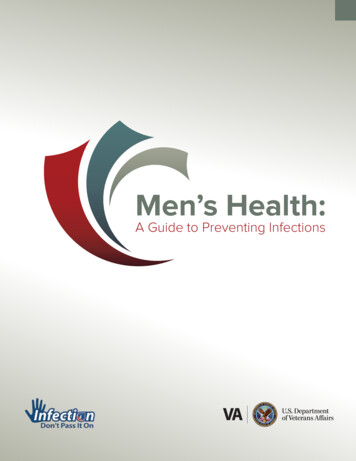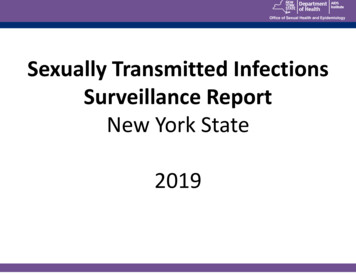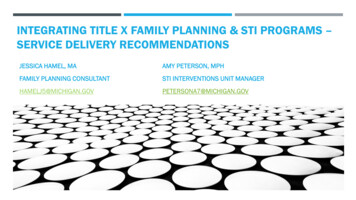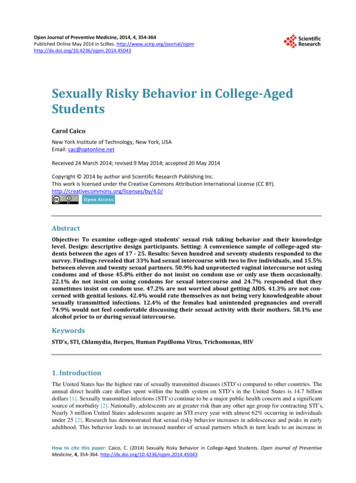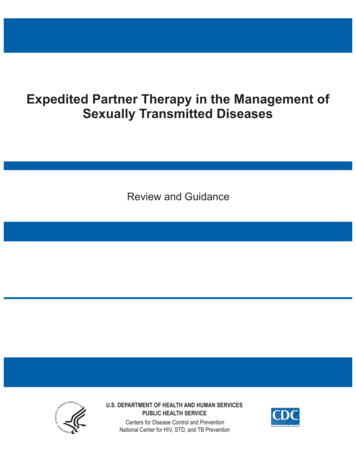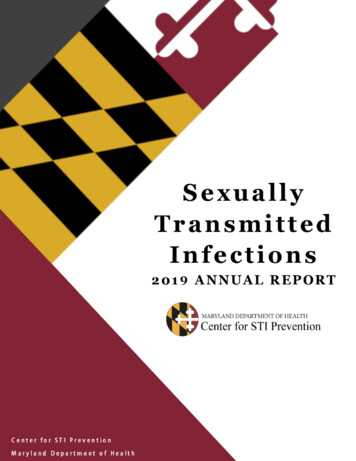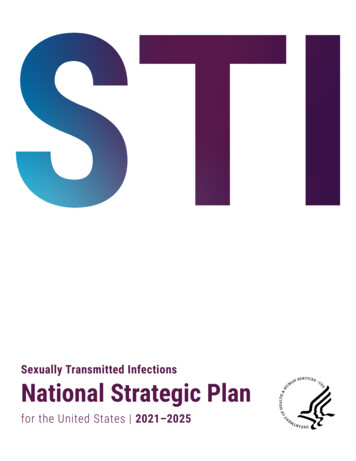
Transcription
Sexually Transmitted InfectionsNational Strategic Planfor the United States 2021–2025
VISIONThe United States will be a place where sexually transmitted infectionsare prevented and where every person has high-quality STI prevention,care, and treatment while living free from stigma and discrimination.This vision includes all people, regardless of age, sex, gender identity,sexual orientation, race, ethnicity, religion, disability, geographic location,or socioeconomic circumstance.STI National Strategic Plan: 2021–2025i
Acknowledgments: The Sexually Transmitted Infections National Strategic Plan (STI Plan) was developedthrough a robust process that included gathering feedback from stakeholders across health care and relatedfields. Partners throughout the federal government, as well as hundreds of nonfederal stakeholders, includingstate, tribal, territorial, and local governments, researchers, health plans and providers, community groups, andnational and local organizations that work in STI and related fields, have helped shape the goals, objectives,and strategies in this plan. The Office of the Assistant Secretary for Health (OASH) and its Office of InfectiousDisease and HIV/AIDS Policy (OIDP) of the U.S. Department of Health and Human Services (HHS) sincerelythank all those who contributed to making this STI Plan a reality, especially staff from the Centers for DiseaseControl and Prevention (CDC) Division of STD Prevention who provided technical and personnel support.Language used in the STI Plan: The STI Plan places value on the lived experiences and choices of all people,regardless of age, sex, gender identity, sexual orientation, race, ethnicity, religion, disability, geographiclocation, or socioeconomic circumstance. To reflect this vision, a concerted effort was made to use inclusiveand person-first language throughout the STI Plan. Evidence-based, contemporary terminology is alsoused to convey respect and empowerment and to reduce stigma faced by communities and populationsdisproportionately impacted by these infections. Despite these efforts, specific terminology or language maybe unintentionally offensive or stigmatizing to some individuals or populations. Language is subjective, andthe meaning and use of language changes over time. This approach is intended to help the STI Plan’s users toidentify these societal shifts in preferred terminology and to communicate in a manner that reflects its visionfor a collective, inclusive, and respectful national response.Additional information regarding the STI Plan and associated activities may be accessed at www.hhs.gov/STI.Suggested citation: U.S. Department of Health and Human Services. 2020. Sexually Transmitted InfectionsNational Strategic Plan for the United States: 2021–2025. Washington, DC.STI National Strategic Plan: 2021–2025ii
TABLE OF CONTENTSExecutive Summary.1I. Introduction.4A. The Need for a STI National Strategic Plan.4B. The STI Epidemic: Challenges and Opportunities.6C. Scope, Approach, and Development of the STI National Strategic Plan. 11II. Overview of Each STI. 14A. Chlamydia. 15B. Gonorrhea. 17C. Syphilis. 19D. HPV and HPV Vaccination. 23III. STI National Strategic Plan. 25A. Vision. 25B. Goals. 25C. Objectives and Strategies. 26D. Priority Populations and Geographic Areas. 38E. Indicators. 43IV. Implementation and Accountability. 49A. Federal Partners. 49B. Nonfederal Partners. 49Appendix A: Process/Methodology for Developing and Adopting the STI Plan. 50Appendix B: Indicators and Targets. 55Appendix C: Federal Steering Committee, Subcommittees, and Staff. 58Appendix D: Acronyms. 63Appendix E: References. 65STI National Strategic Plan: 2021–2025iii
Tables, Figures, and BoxesTablesTable 1.Definitions Included in the STI Plan.26Table 2.Priority Populations and Summary National-Level Data, Calendar Year 2018.39Table 3.STI Plan Core Indicators.44Table 4.STI Plan Disparities Indicators.47Table A.1. Composition of Federal Steering Committee.50STI Plan Core Indicators.55Table B.2. STI Plan Disparities Indicators.56FiguresFigure 1.Chlamydia—Rates per 100,000 of reported cases by sex, United States, 2009–2018.16Figure 2.Gonorrhea—Rates per 100,000 of reported cases by sex, United States, 2009–2018.18Figure 3.P&S Syphilis—Rates per 100,000 of reported cases by sex, United States, 2009–2018.20Figure 4.Congenital Syphilis—Reported rates by year of birth and reported rates of P&S syphilis . .among females aged 15–44, United States, 2009–2018.21Figure 5.Disparities in reported rates of STIs by race/ethnicity, 2018.40Figure 6.Rates of reported cases by state, per 100,000 population, 2018.41Figure 7.Percentage of adolescents who have received at least one dose of the HPV vaccine, 2018.42Figure A.1. Respondent type for all public commenters with available affiliation.52BoxesBox 1.Ending the HIV Epidemic: A Plan for America.13Box 2.STI Surveillance and Fact Sheets.14Box 3.Chlamydia Snapshot.15Box 4.Gonorrhea Snapshot.17Box 5.Syphilis Snapshot.19Box 6.HPV and HPV Vaccination Snapshot.23STI National Strategic Plan: 2021–2025iv
EXECUTIVE SUMMARYOver the past decade, the United States has witnessed alarming increases in rates of sexually transmittedinfections (STIs) including syphilis, chlamydia, and gonorrhea, amounting to a public health crisis. From 2014to 2018, the rates of reported cases of primary and secondary syphilis, congenital syphilis, gonorrhea, andchlamydia rose 71%, 185%, 63%, and 19%, respectively. Human papillomavirus (HPV), the most common STI,accounts for 14 million new infections each year.The consequences of the STI epidemic are enormous. When left untreated, STIs can lead to long-term,irreversible health outcomes such as chronic pelvic pain, infertility, adverse pregnancy outcomes, neonataldeath, and congenital abnormalities, and can facilitate HIV acquisition. HPV can cause numerous formsof cancer, although most HPV types associated with cancer are preventable through vaccination. HPVvaccination rates are lower than for other routinely recommended childhood and adolescent vaccinations inthe United States despite evidence that the vaccine has a substantial impact on reducing HPV infections, HPVassociated pre-cancers, cancers, and genital warts. Many Americans largely underestimate the risk of STIsand for myriad reasons may not proactively seek care. In addition, racial and ethnic disparities contribute to anunequal burden of STIs in the United States.As recognized by several national reports and authorities, efforts to date to address STIs have beenfragmented and insufficient. Despite actions to reverse the trend, resources are often strained in many stateand local public health settings. In addition, STIs cost Americans billions of dollars each year in direct medicalexpenses. Combined, the health and economic toll can affect the quality of life and prosperity of millionsof people. Coordinated, innovative approaches and sustained efforts are needed to reverse this increasingtrajectory and to curtail the ever-growing burden of STIs.This inaugural STI National Strategic Plan (STI Plan) sets forth a vision for the nation with goals, objectives,and strategies to meaningfully prevent and control STIs in the United States. It is intended to serve as aroadmap for federal and nonfederal stakeholders at all levels to reverse the upward trends in STI rates. TheSTI Plan focuses on four of the STIs with the highest morbidity rates, the most persistent and pervasiveSTI inequalities according to national data, and the greatest impact on the health of the nation: chlamydia,gonorrhea, syphilis, and HPV. HIV, another significant STI, is the focus of a separate HIV National StrategicPlan. Hepatitis B and hepatitis C, which can also be transmitted sexually, are the focus of a separate ViralHepatitis National Strategic Plan.The STI Plan also includes indicators to measure progress and quantitative targets for each indicator. Thecomponents of the STI Plan are contained and discussed in Section III.The STI Plan establishes the following vision:VISIONThe United States will be a place where sexually transmitted infectionsare prevented and where every person has high-quality STI prevention,care, and treatment while living free from stigma and discrimination.This vision includes all people, regardless of age, sex, gender identity,sexual orientation, race, ethnicity, religion, disability, geographic location,or socioeconomic circumstance.STI National Strategic Plan: 2021–2025Executive Summary 1
This vision is accompanied by five high-level goals, which frame the STI Plan’s more specific objectives. Theorder of goals and objectives does not indicate any prioritization, and many are intertwined. The five goals andassociated objectives are as follows:Goal 1: Prevent New STIs1.1Increase awareness of STIs and sexual health1.2Expand implementation of quality, comprehensive STI primary prevention activities1.3Increase completion rates of routinely recommended HPV vaccination1.4Increase the capacity of public health, health care delivery systems, and the healthworkforce to prevent STIsGoal 2: Improve the Health of People by Reducing Adverse Outcomes of STIs2.1Expand high-quality affordable STI secondary prevention, including screening, care, andtreatment, in communities and populations most impacted by STIs2.2Work to effectively identify, diagnose, and provide holistic care and treatment for peoplewith STIs by increasing the capacity of public health, health care delivery systems, and thehealth workforceGoal 3: Accelerate Progress in STI Research, Technology, and Innovation3.1Support research and investments to develop STI vaccines and bring them to market3.2Support the development and uptake of STI multipurpose prevention technologies,antimicrobial prophylaxis regimens, and other preventive products and strategies3.3Support the development and uptake of innovative STI diagnostic technologies, therapeuticagents, and other interventions for the identification and treatment of STIs, including newand emerging disease threats3.4Identify, evaluate, and scale up best practices in STI prevention and treatment, includingthrough translational, implementation, and communication science researchGoal 4: Reduce STI-Related Health Disparities and Health Inequities4.1Reduce stigma and discrimination associated with STIs4.2Expand culturally competent and linguistically appropriate STI prevention, care, andtreatment services in communities disproportionately impacted by STIs4.3Address STI-related social determinants of health and co-occurring conditionsGoal 5: Achieve Integrated, Coordinated Efforts That Address the STI Epidemic5.1Integrate programs to address the syndemic of STIs, HIV, viral hepatitis, and substance usedisorders5.2Improve quality, accessibility, timeliness, and use of data related to STIs and socialdeterminants of health5.3Improve mechanisms to measure, monitor, evaluate, report, and disseminate progresstoward achieving national STI goalsSTI National Strategic Plan: 2021–2025Executive Summary 2
The vision, goals, objectives, and other components of the STI Plan were developed and approved by adedicated Steering Committee, composed of subject matter experts from across the federal government, withpublic comment from numerous and varied stakeholders. The STI Plan is designed to be accessible to a broadaudience, including people working in public health, health care, government, community-based organizations,private industry, research, and academia. It serves as a roadmap for all stakeholders at all levels to guidedevelopment of policies, initiatives, and actions for STI prevention and control. Because certain demographicgroups and areas are disproportionately impacted by STIs, the STI Plan also identifies populations andgeographic regions with higher rates of STIs (i.e., priority populations) so that federal agencies and otherstakeholders can focus their resources to realize the greatest impact. The priority populations were identifiedbased on national-level data. Stakeholders are encouraged to review the data for the populations they serve tohelp focus their efforts.Interwoven throughout the STI Plan are approaches to address the individual, community, and structuralfactors and inequities that contribute to the spread of STIs, such as stigma and social determinants of health.The STI Plan highlights opportunities to integrate STI prevention and control into HIV, viral hepatitis, substanceuse disorders, and other public health efforts by leveraging capacity and infrastructure across the domains andbreaking down operational and funding silos.A recurring theme is the need for innovative solutions and approaches to address the ongoing and emergingchallenges to STI prevention and control, including expanding the types of community and clinical sites thataddress STIs and developing vaccines, point-of-care diagnostic tools, and therapeutics. The plan is designedto facilitate a whole-of-nation response to the STI epidemic in the United States and to successfully preventand reduce STI-associated morbidity and mortality.The STI Plan includes indicators for measuring progress and quantitative targets for each indicator. Thereare seven core indicators, some of which are stratified to measure progress in addressing disparities in STIs(i.e., disparities indicators). Although focused on the years 2021–2025, the STI Plan includes annual targetsthrough 2030 because STIs will continue to pose a threat to the public’s health. To ensure implementationand accountability, a Federal Implementation Plan that documents the specific actions that federal partnerswill take to achieve the STI Plan’s goals and objectives will be released subsequent to the STI Plan. Progresstoward meeting the STI Plan’s goals will be monitored and reported annually.STI National Strategic Plan: 2021–2025Executive Summary 3
I. INTRODUCTIONA. The Need for the STI National Strategic Plan1. RISE IN STIs AND PURPOSE OF THE PLANPersistent rises in the rates of sexually transmitted infections (STIs) in the United States constitute an epidemicand public health crisis with profound implications for all Americans. In recent decades, rates of chlamydia,gonorrhea, syphilis, and congenital syphilis have increased significantly. The rate of chlamydia, the mostcommonly reported bacterial STI, increased by approximately 19% from 2011 to 2018.1 Over the span of adecade, the rate of gonorrhea rose by greater than 80% from a historic low in 2009. The rates of primary andsecondary syphilis and of congenital syphilis increased almost every year since 2001 and 2012, respectively.Human papillomavirus (HPV), the most common viral STI, accounts for 14 million new STI infections each year.2Left untreated, STIs can lead to serious health consequences such as pelvic inflammatory disease (PID), chronicabdominal pain, infertility, ectopic pregnancy, miscarriage, neonatal death, and congenital abnormalities.1Chlamydia, gonorrhea, and syphilis are also associated with increased risk of HIV transmission.3 HPV leads toapproximately 35,000 cases of cancer in both men and women each year, despite being preventable through asafe and effective vaccine.2In the United States, some groups are more affected by STIs than others.1 People aged 15–24 represent onehalf of new STI infections, but only one-quarter of the sexually active population.4 In 2018, more than one-halfof primary and secondary syphilis infections occurred among men who have sex with men (MSM).1 In addition,rates of chlamydia, gonorrhea, and syphilis are higher among American Indians/Alaska Natives (AI/AN) andAfrican Americans (Blacks)* than among whites.5 The South and West, as defined by the U.S. Census Bureau,6are the U.S. regions most heavily impacted by the STI epidemic.STIs significantly impact the U.S. economy and health caresystem. A 2008 analysis from the Centers for DiseaseControl and Prevention (CDC) estimated the total directcost of chlamydia, gonorrhea, syphilis, and HPV was 2.4billion annually.7 This estimate does not include the costof adverse pregnancy outcomes, productivity losses dueto illness, and the cost of STI screening and preventionprograms.7To spur action to reduce STI rates and their public healthimpacts, the U.S. Department of Health and Human Services(HHS) led the development of this inaugural STI NationalStrategic Plan (STI Plan or Plan). The STI Plan outlinesnational goals, objectives, strategies, and indicators totarget four of the STIs with the highest morbidity rates, themost persistent and pervasive STI inequalities according tonational data, and the greatest impact on the health of thenation: chlamydia, gonorrhea, syphilis, and HPV. † However,most of its components are also applicable to other STIs,such as herpes simplex virus infection, trichomoniasis, andThe term sexually transmitted infection(STI) refers to a virus, bacteria, fungus,or parasite that has infected a person’sbody via sexual contact, whereas theterm sexually transmitted disease (STD)refers to a recognizable disease statethat has developed from an STI. Somestakeholders commonly use the termSTI, and some commonly use the termSTD. This STI Plan generally uses theterm STI because the goal is to preventand treat infections before they developinto a disease state. However, the termSTD is used when referring to data orinformation from sources that use theterm STD.In this STI Plan, Blacks will be used to refer to African Americans and Blacks.HIV, another significant STI, is addressed in a separate HIV National Strategic Plan (HIV Plan). Hepatitis B and hepatitis C, which can also betransmitted sexually, are addressed in a separate Viral Hepatitis National Strategic Plan (Hepatitis Plan).*†STI National Strategic Plan: 2021–2025I. Introduction 4
Mycoplasma genitalium. A roadmap for federal and nonfederal stakeholders at all levels and sectors, the STIPlan envisions a whole-of-nation response to preventing and controlling STIs in the United States.2. NATIONAL STI REPORTS: A CALL TO ACTIONSeveral foundational reports have been published on the STI epidemic, its impact on public health, andpossible solutions to the crisis. These critical calls to action helped guide this STI Plan.A groundbreaking 1997 report from the Institute of Medicine (IOM), The Hidden Epidemic: Confronting SexuallyTransmitted Diseases, concluded that “the scope and impact of the STI epidemic are underappreciated.and largely hidden from public discourse.”8(p20) The reasons for this under-appreciation remain as relevanttoday. STIs may be asymptomatic and therefore undetected; a significant amount of time may lapse betweeninitial infection and serious health consequences (e.g., infertility and HPV-associated cancers); and stigmaassociated with STIs inhibits traditional interventions such as education and public discourse. The report alsohighlighted other important drivers of the epidemic, including social determinants of health such as poverty,lack of education, and disparities in health care access.A panel of the National Academy of Public Administration (NAPA), on behalf of the National Coalition of STDDirectors (NCSD), released two reports in 2018 and 2019 that expanded on the IOM report.9,10 The NAPAreports, which explored the effectiveness of STI prevention and control efforts as well as the challenges offrontline programs, highlighted many of the same themes and recommendations. Their findings documentedreductions in federal, state, and local funding that have left programs without the resources or capacityto provide the STI prevention and treatment services needed to respond to increasing STI rates. Further,technology challenges—such as incompatibility across surveillance systems, the inability to link electronichealth record data, and the lack of public health informatics staff—are hindering the collection, reporting, anduse of surveillance data essential to prevention and control activities.Funding restrictions often prevent integrated, coordinated programing necessary to address contributingfactors to STIs. In addition, the closing of many STI clinics has left vulnerable populations without access totimely sexual health care. Social stigma remains an overriding issue on the frontlines and a continuing barrierto STI education and screening. The reports underscored that many entities are involved in STI mitigation andrecommended development of a comprehensive, unified national strategy to combat STIs, which would includethe following specific actions. Designate a national STI champion to coordinate federal, state, and local efforts and to lead thedevelopment and implementation of a national STI strategy. Frame the STI narrative as a health and wellness issue to destigmatize the discourse. Expand science-based, health-centric STI education and awareness among the public and healthcare providers to reduce stigma, encourage healthy behaviors, and increase screening, testing, andtreatments. Expand access to care, with a focus on delivering community-sensitive and patient-centered care. Improve data collection, reporting, and evaluation and enable more research to inform interventions andbring best practices to scale. Expand funding and resources and enhance agility across STI programs.In another 2019 report commissioned by NCSD, the Treatment Action Group (TAG) highlighted serious gapsin the development of new tools for STI prevention (e.g., vaccines), diagnostics/testing (e.g., rapid tests),and treatment and called for major new investment in STI research.11 TAG recommendations for communityadvocates and key stakeholders included the following: Invest substantially in new prevention modalities, particularly vaccine research and development forchlamydia, gonorrhea, and syphilis.STI National Strategic Plan: 2021–2025I. Introduction 5
Consider scaling up pre-exposure prophylaxis (PrEP) and/or post-exposure prophylaxis (PEP) for syphilisand chlamydia. Pave the way for development and access to novel antibiotics for treatment of gonorrhea. Develop reliable, easy-to-use, widely accessible (including point-of-care [POC] and self-testing) rapidtests for STIs. Focus STI advocacy efforts to aggressively address structural, social, financial, and research barriers, inaddition to condoms and behavioral interventions. Synergize STI and HIV advocacy—STI prevention and treatment success is integral to the success of HIVprevention and treatment. Address underfunding and declining funding of STI infrastructure and clinics in the United States.These frameworks and calls to action recognize and highlight the need for a cohesive national approachto address the STI epidemic. Other national frameworks have also informed this STI plan and include TheSurgeon General’s Call to Action to Promote Sexual Health and Responsible Sexual Behavior (2001),12 theNational Prevention Strategy (2011),13 the National Strategy for Combating Antibiotic Resistant Bacteria (CARB)(2014),14 and the Healthy People framework.15B. The STI Epidemic: Challenges and OpportunitiesSeveral challenges must be addressed to curtail the rising STI rates. Although the United States is in the midstof an STI epidemic and more than one-half of Americans will acquire an STI in their lifetime, a large majorityremain unaware of the high prevalence of STIs.16 Disparities in rates among certain population groups andgeographic regions highlight the need for focused prevention strategies that address contributing factors suchas health behaviors, substance use, stigma, and social determinants of health.1 Other ongoing and emergingchallenges must also be addressed including workforce skill and program capacity, the increasing threat ofantimicrobial resistance (AMR), and the need for innovations in STI prevention, diagnosis, and treatment. Toreverse the high rates of STIs, the field must shift from a fragmented and insufficient approach to one that iscoordinated, sustained, and population-based and leverages innovation.9, 17Many aspects of the STI epidemic are intertwined with other public health challenges such as HIV, viralhepatitis, and substance use disorders (SUDs). For example, stigma crosscuts each of these issues and leadsto significant disparities as well as prevention and treatment challenges. The STI Plan provides a frameworkfor addressing many of these challenges and opportunities in an integrated fashion.1. HEALTH DISPARITIES, STIGMA, AND THE ROLE OF SOCIAL DETERMINANTS OF HEALTHSocial determinants of health—the social and economic conditions that influence the health of individuals andcommunities—loom large in the STI epidemic and the unequal burden of STIs in the United States. Individualbehaviors that contribute to STIs occur in a broad context that involves a complex interplay of factors such aspoverty, stigma, housing and food insecurity, discrimination, racism, medical mistrust, violence/trauma, accessto care, and education.Stigma, driven by medical, social, and cultural conditions, has long been a challenge in the prevention andcontrol of STIs. Even when other barriers (e.g., health care access) are eliminated, stigma can discourageindividuals from seeking STI testing and treatment.18 Stigmatizing attitudes that associate STIs withimmoral or irresponsible behavior hinder public discourse, disclosure, information sharing, care-seeking, andtreatment.19 Bias in provider behavior and interactions with patients may inhibit patients from seeking testingand accepting STI prevention e
STI Plan focuses on four of the STIs with the highest morbidity rates, the most persistent and pervasive STI inequalities according to national data, and the greatest impact on the health of the nation: chlamydia, gonorrhea, syphilis, and HPV. HIV, another significant STI, is the focus of a separate HIV National Strategic Plan.
